Portrayal of Indigenous Australians in the Media
VerifiedAdded on 2023/04/03
|10
|2126
|301
AI Summary
This essay reviews three media articles on smoking among Indigenous Australians and analyzes their impact on perceptions and stereotypes. It explores the role of media in shaping health outcomes and emphasizes the importance of cultural safety and intercultural communication. The articles highlight the progress made in reducing smoking rates among Indigenous Australians, the historical context of smoking, and the programs aimed at helping Indigenous people quit smoking.
Contribute Materials
Your contribution can guide someone’s learning journey. Share your
documents today.
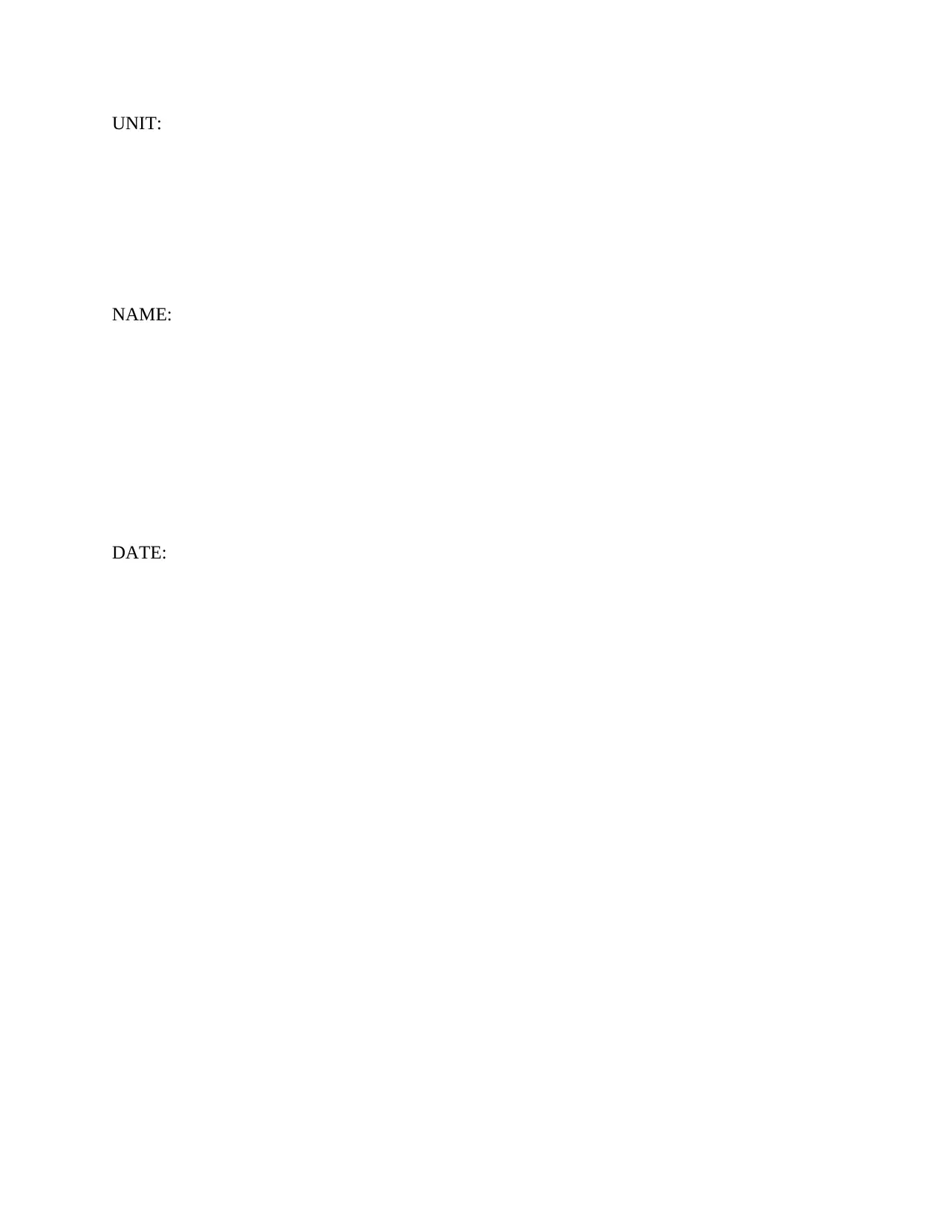
UNIT:
NAME:
DATE:
NAME:
DATE:
Secure Best Marks with AI Grader
Need help grading? Try our AI Grader for instant feedback on your assignments.
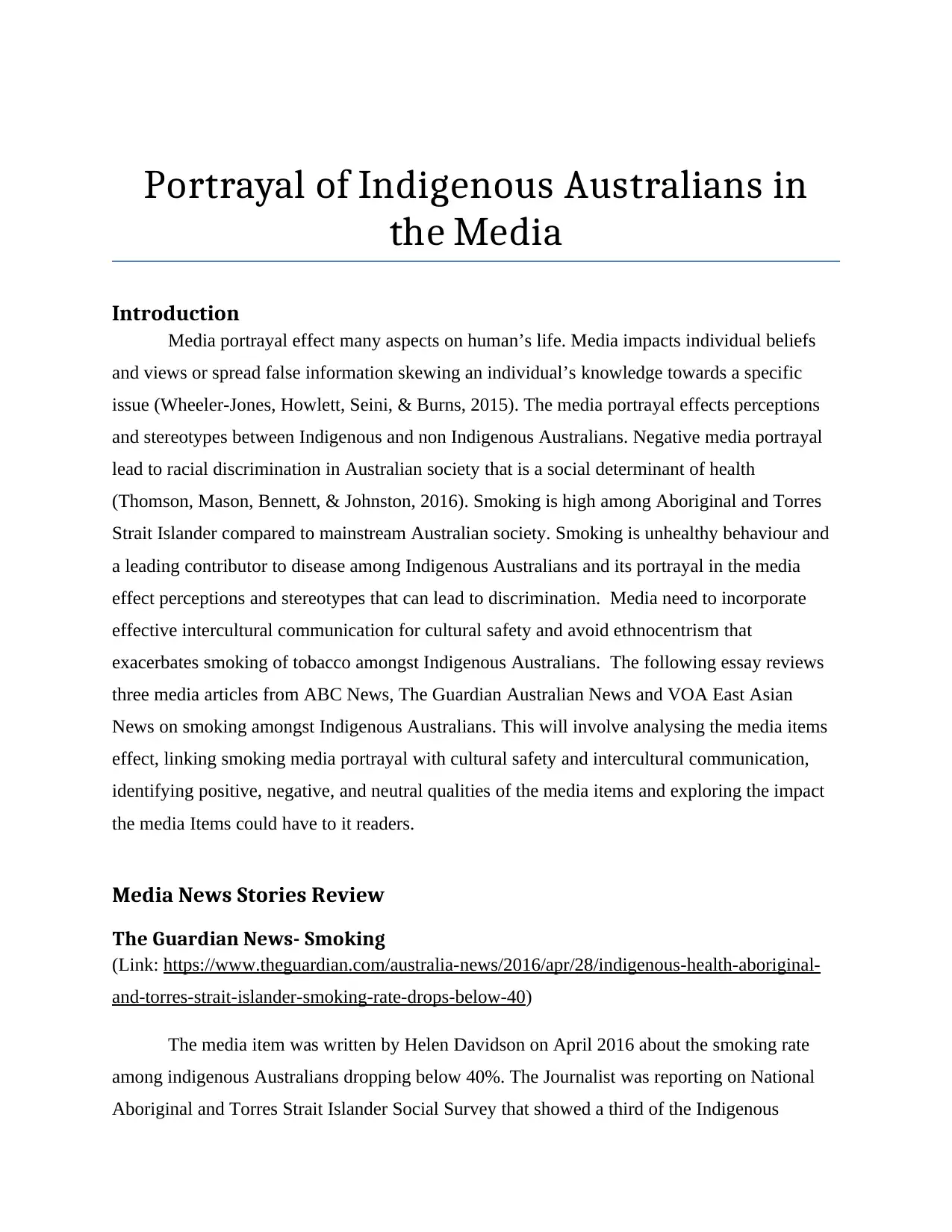
Portrayal of Indigenous Australians in
the Media
Introduction
Media portrayal effect many aspects on human’s life. Media impacts individual beliefs
and views or spread false information skewing an individual’s knowledge towards a specific
issue (Wheeler-Jones, Howlett, Seini, & Burns, 2015). The media portrayal effects perceptions
and stereotypes between Indigenous and non Indigenous Australians. Negative media portrayal
lead to racial discrimination in Australian society that is a social determinant of health
(Thomson, Mason, Bennett, & Johnston, 2016). Smoking is high among Aboriginal and Torres
Strait Islander compared to mainstream Australian society. Smoking is unhealthy behaviour and
a leading contributor to disease among Indigenous Australians and its portrayal in the media
effect perceptions and stereotypes that can lead to discrimination. Media need to incorporate
effective intercultural communication for cultural safety and avoid ethnocentrism that
exacerbates smoking of tobacco amongst Indigenous Australians. The following essay reviews
three media articles from ABC News, The Guardian Australian News and VOA East Asian
News on smoking amongst Indigenous Australians. This will involve analysing the media items
effect, linking smoking media portrayal with cultural safety and intercultural communication,
identifying positive, negative, and neutral qualities of the media items and exploring the impact
the media Items could have to it readers.
Media News Stories Review
The Guardian News- Smoking
(Link: https://www.theguardian.com/australia-news/2016/apr/28/indigenous-health-aboriginal-
and-torres-strait-islander-smoking-rate-drops-below-40)
The media item was written by Helen Davidson on April 2016 about the smoking rate
among indigenous Australians dropping below 40%. The Journalist was reporting on National
Aboriginal and Torres Strait Islander Social Survey that showed a third of the Indigenous
the Media
Introduction
Media portrayal effect many aspects on human’s life. Media impacts individual beliefs
and views or spread false information skewing an individual’s knowledge towards a specific
issue (Wheeler-Jones, Howlett, Seini, & Burns, 2015). The media portrayal effects perceptions
and stereotypes between Indigenous and non Indigenous Australians. Negative media portrayal
lead to racial discrimination in Australian society that is a social determinant of health
(Thomson, Mason, Bennett, & Johnston, 2016). Smoking is high among Aboriginal and Torres
Strait Islander compared to mainstream Australian society. Smoking is unhealthy behaviour and
a leading contributor to disease among Indigenous Australians and its portrayal in the media
effect perceptions and stereotypes that can lead to discrimination. Media need to incorporate
effective intercultural communication for cultural safety and avoid ethnocentrism that
exacerbates smoking of tobacco amongst Indigenous Australians. The following essay reviews
three media articles from ABC News, The Guardian Australian News and VOA East Asian
News on smoking amongst Indigenous Australians. This will involve analysing the media items
effect, linking smoking media portrayal with cultural safety and intercultural communication,
identifying positive, negative, and neutral qualities of the media items and exploring the impact
the media Items could have to it readers.
Media News Stories Review
The Guardian News- Smoking
(Link: https://www.theguardian.com/australia-news/2016/apr/28/indigenous-health-aboriginal-
and-torres-strait-islander-smoking-rate-drops-below-40)
The media item was written by Helen Davidson on April 2016 about the smoking rate
among indigenous Australians dropping below 40%. The Journalist was reporting on National
Aboriginal and Torres Strait Islander Social Survey that showed a third of the Indigenous
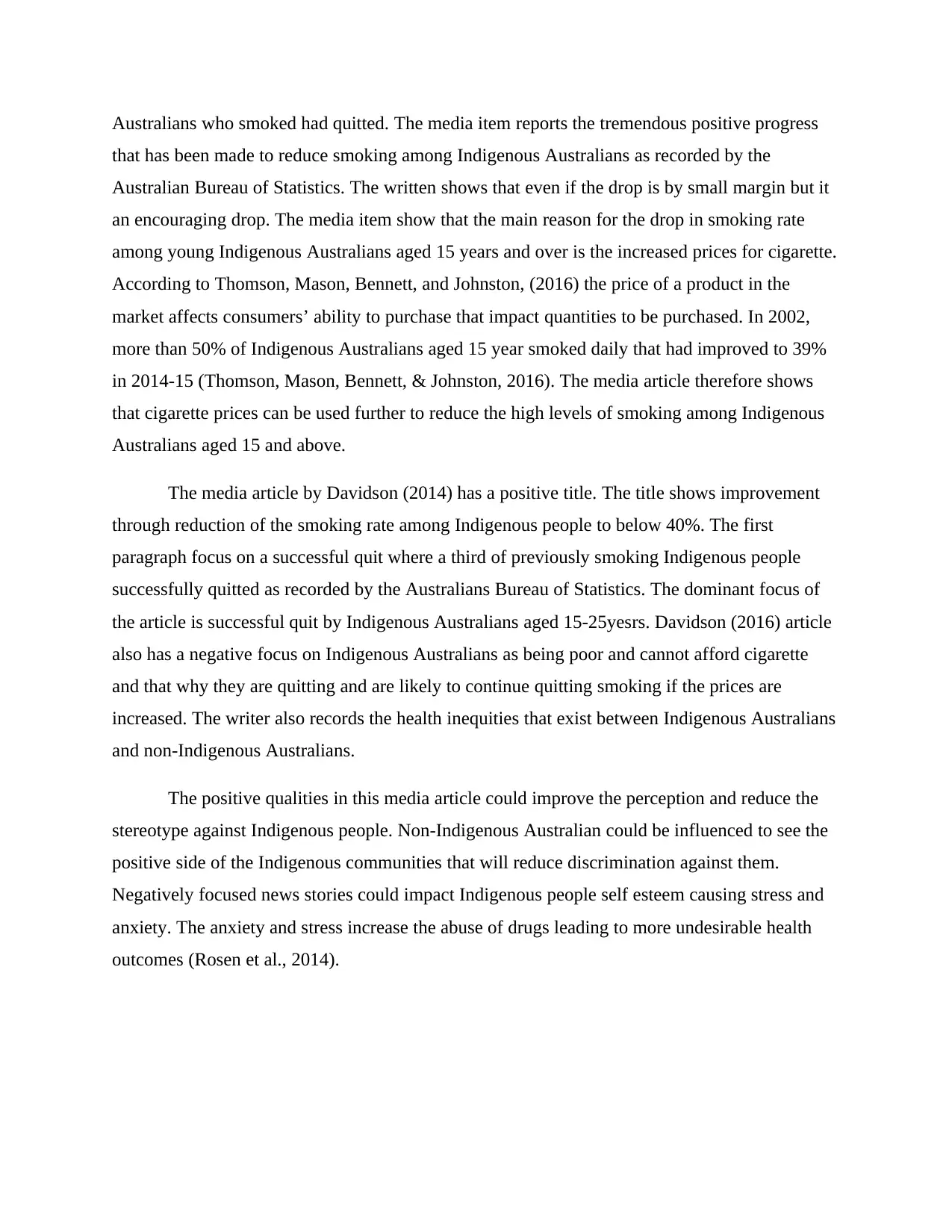
Australians who smoked had quitted. The media item reports the tremendous positive progress
that has been made to reduce smoking among Indigenous Australians as recorded by the
Australian Bureau of Statistics. The written shows that even if the drop is by small margin but it
an encouraging drop. The media item show that the main reason for the drop in smoking rate
among young Indigenous Australians aged 15 years and over is the increased prices for cigarette.
According to Thomson, Mason, Bennett, and Johnston, (2016) the price of a product in the
market affects consumers’ ability to purchase that impact quantities to be purchased. In 2002,
more than 50% of Indigenous Australians aged 15 year smoked daily that had improved to 39%
in 2014-15 (Thomson, Mason, Bennett, & Johnston, 2016). The media article therefore shows
that cigarette prices can be used further to reduce the high levels of smoking among Indigenous
Australians aged 15 and above.
The media article by Davidson (2014) has a positive title. The title shows improvement
through reduction of the smoking rate among Indigenous people to below 40%. The first
paragraph focus on a successful quit where a third of previously smoking Indigenous people
successfully quitted as recorded by the Australians Bureau of Statistics. The dominant focus of
the article is successful quit by Indigenous Australians aged 15-25yesrs. Davidson (2016) article
also has a negative focus on Indigenous Australians as being poor and cannot afford cigarette
and that why they are quitting and are likely to continue quitting smoking if the prices are
increased. The writer also records the health inequities that exist between Indigenous Australians
and non-Indigenous Australians.
The positive qualities in this media article could improve the perception and reduce the
stereotype against Indigenous people. Non-Indigenous Australian could be influenced to see the
positive side of the Indigenous communities that will reduce discrimination against them.
Negatively focused news stories could impact Indigenous people self esteem causing stress and
anxiety. The anxiety and stress increase the abuse of drugs leading to more undesirable health
outcomes (Rosen et al., 2014).
that has been made to reduce smoking among Indigenous Australians as recorded by the
Australian Bureau of Statistics. The written shows that even if the drop is by small margin but it
an encouraging drop. The media item show that the main reason for the drop in smoking rate
among young Indigenous Australians aged 15 years and over is the increased prices for cigarette.
According to Thomson, Mason, Bennett, and Johnston, (2016) the price of a product in the
market affects consumers’ ability to purchase that impact quantities to be purchased. In 2002,
more than 50% of Indigenous Australians aged 15 year smoked daily that had improved to 39%
in 2014-15 (Thomson, Mason, Bennett, & Johnston, 2016). The media article therefore shows
that cigarette prices can be used further to reduce the high levels of smoking among Indigenous
Australians aged 15 and above.
The media article by Davidson (2014) has a positive title. The title shows improvement
through reduction of the smoking rate among Indigenous people to below 40%. The first
paragraph focus on a successful quit where a third of previously smoking Indigenous people
successfully quitted as recorded by the Australians Bureau of Statistics. The dominant focus of
the article is successful quit by Indigenous Australians aged 15-25yesrs. Davidson (2016) article
also has a negative focus on Indigenous Australians as being poor and cannot afford cigarette
and that why they are quitting and are likely to continue quitting smoking if the prices are
increased. The writer also records the health inequities that exist between Indigenous Australians
and non-Indigenous Australians.
The positive qualities in this media article could improve the perception and reduce the
stereotype against Indigenous people. Non-Indigenous Australian could be influenced to see the
positive side of the Indigenous communities that will reduce discrimination against them.
Negatively focused news stories could impact Indigenous people self esteem causing stress and
anxiety. The anxiety and stress increase the abuse of drugs leading to more undesirable health
outcomes (Rosen et al., 2014).
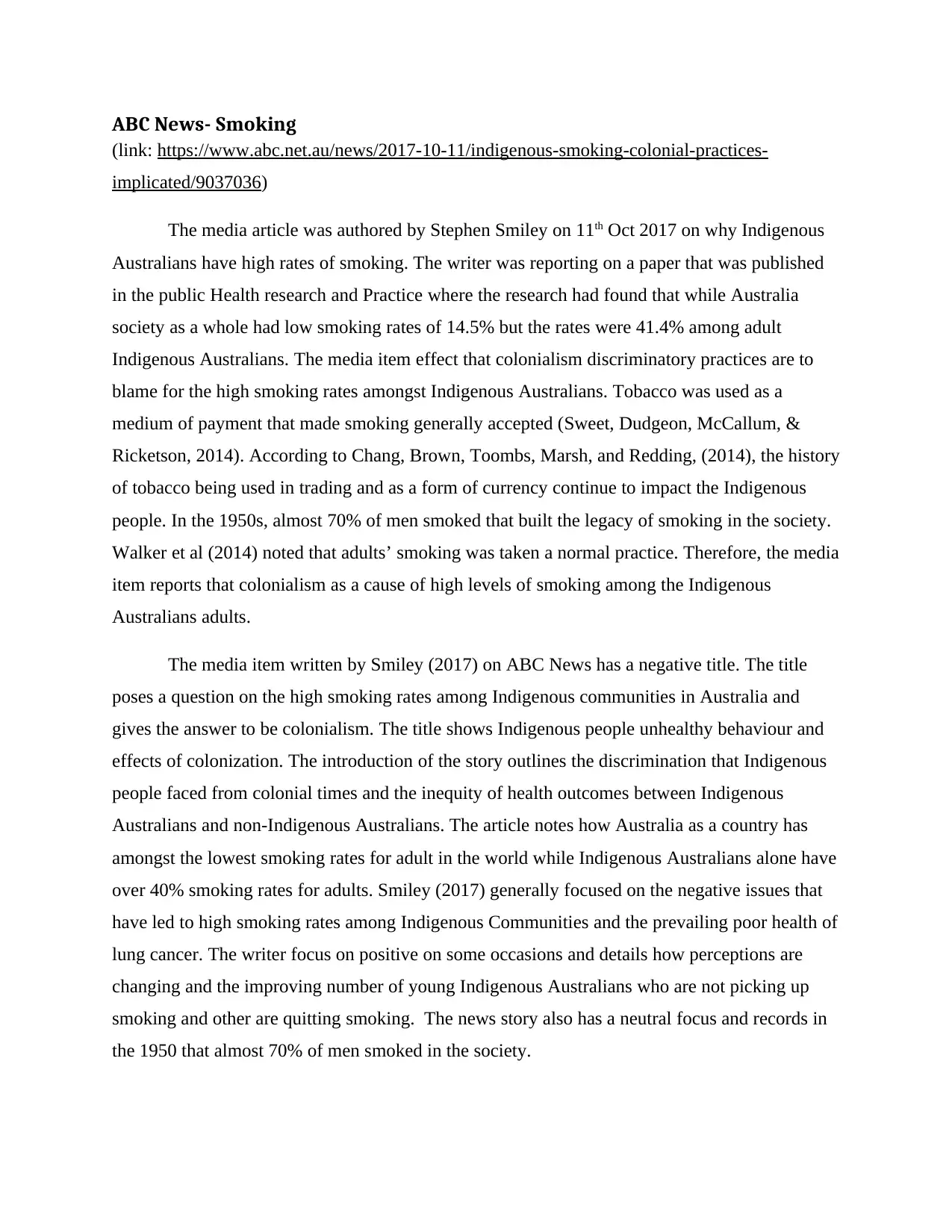
ABC News- Smoking
(link: https://www.abc.net.au/news/2017-10-11/indigenous-smoking-colonial-practices-
implicated/9037036)
The media article was authored by Stephen Smiley on 11th Oct 2017 on why Indigenous
Australians have high rates of smoking. The writer was reporting on a paper that was published
in the public Health research and Practice where the research had found that while Australia
society as a whole had low smoking rates of 14.5% but the rates were 41.4% among adult
Indigenous Australians. The media item effect that colonialism discriminatory practices are to
blame for the high smoking rates amongst Indigenous Australians. Tobacco was used as a
medium of payment that made smoking generally accepted (Sweet, Dudgeon, McCallum, &
Ricketson, 2014). According to Chang, Brown, Toombs, Marsh, and Redding, (2014), the history
of tobacco being used in trading and as a form of currency continue to impact the Indigenous
people. In the 1950s, almost 70% of men smoked that built the legacy of smoking in the society.
Walker et al (2014) noted that adults’ smoking was taken a normal practice. Therefore, the media
item reports that colonialism as a cause of high levels of smoking among the Indigenous
Australians adults.
The media item written by Smiley (2017) on ABC News has a negative title. The title
poses a question on the high smoking rates among Indigenous communities in Australia and
gives the answer to be colonialism. The title shows Indigenous people unhealthy behaviour and
effects of colonization. The introduction of the story outlines the discrimination that Indigenous
people faced from colonial times and the inequity of health outcomes between Indigenous
Australians and non-Indigenous Australians. The article notes how Australia as a country has
amongst the lowest smoking rates for adult in the world while Indigenous Australians alone have
over 40% smoking rates for adults. Smiley (2017) generally focused on the negative issues that
have led to high smoking rates among Indigenous Communities and the prevailing poor health of
lung cancer. The writer focus on positive on some occasions and details how perceptions are
changing and the improving number of young Indigenous Australians who are not picking up
smoking and other are quitting smoking. The news story also has a neutral focus and records in
the 1950 that almost 70% of men smoked in the society.
(link: https://www.abc.net.au/news/2017-10-11/indigenous-smoking-colonial-practices-
implicated/9037036)
The media article was authored by Stephen Smiley on 11th Oct 2017 on why Indigenous
Australians have high rates of smoking. The writer was reporting on a paper that was published
in the public Health research and Practice where the research had found that while Australia
society as a whole had low smoking rates of 14.5% but the rates were 41.4% among adult
Indigenous Australians. The media item effect that colonialism discriminatory practices are to
blame for the high smoking rates amongst Indigenous Australians. Tobacco was used as a
medium of payment that made smoking generally accepted (Sweet, Dudgeon, McCallum, &
Ricketson, 2014). According to Chang, Brown, Toombs, Marsh, and Redding, (2014), the history
of tobacco being used in trading and as a form of currency continue to impact the Indigenous
people. In the 1950s, almost 70% of men smoked that built the legacy of smoking in the society.
Walker et al (2014) noted that adults’ smoking was taken a normal practice. Therefore, the media
item reports that colonialism as a cause of high levels of smoking among the Indigenous
Australians adults.
The media item written by Smiley (2017) on ABC News has a negative title. The title
poses a question on the high smoking rates among Indigenous communities in Australia and
gives the answer to be colonialism. The title shows Indigenous people unhealthy behaviour and
effects of colonization. The introduction of the story outlines the discrimination that Indigenous
people faced from colonial times and the inequity of health outcomes between Indigenous
Australians and non-Indigenous Australians. The article notes how Australia as a country has
amongst the lowest smoking rates for adult in the world while Indigenous Australians alone have
over 40% smoking rates for adults. Smiley (2017) generally focused on the negative issues that
have led to high smoking rates among Indigenous Communities and the prevailing poor health of
lung cancer. The writer focus on positive on some occasions and details how perceptions are
changing and the improving number of young Indigenous Australians who are not picking up
smoking and other are quitting smoking. The news story also has a neutral focus and records in
the 1950 that almost 70% of men smoked in the society.
Secure Best Marks with AI Grader
Need help grading? Try our AI Grader for instant feedback on your assignments.
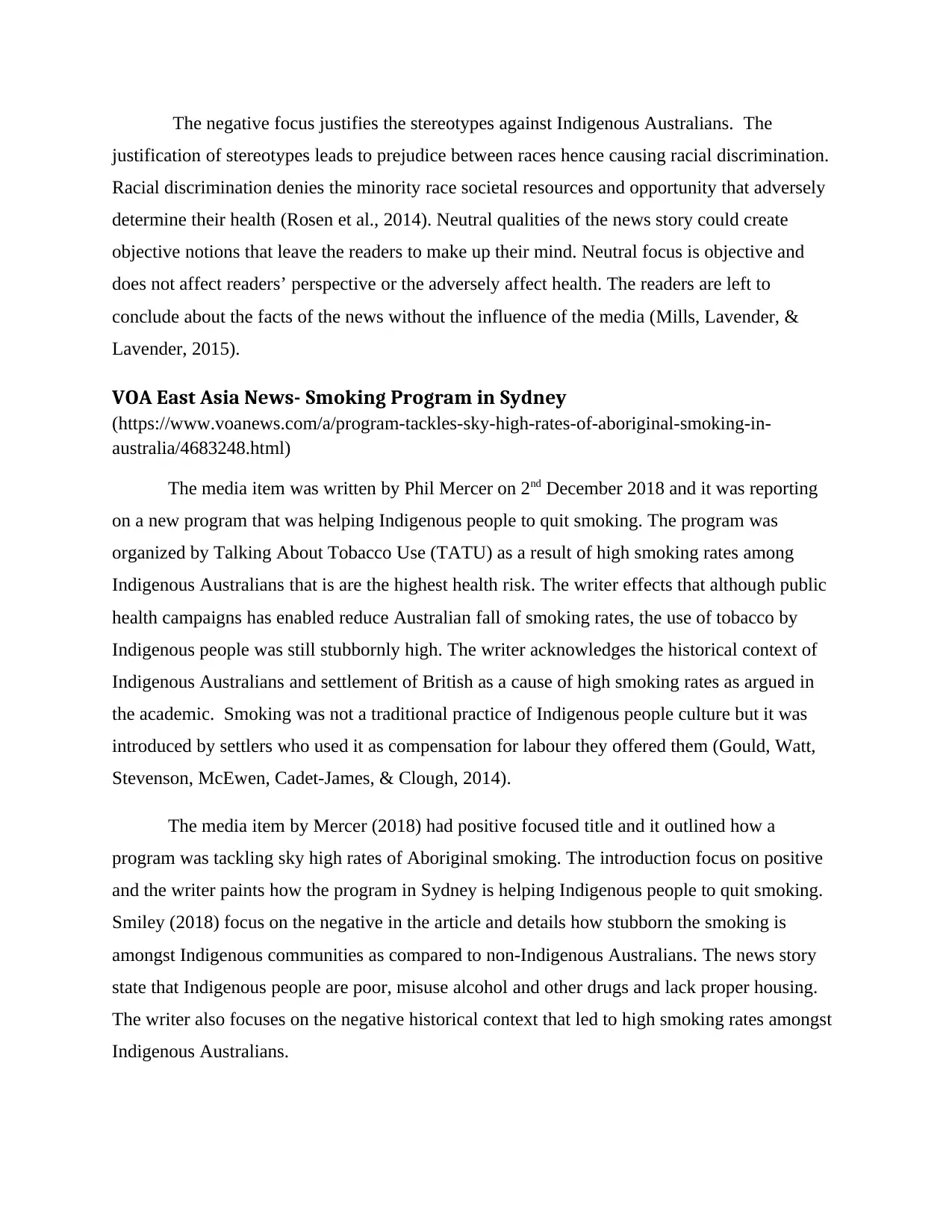
The negative focus justifies the stereotypes against Indigenous Australians. The
justification of stereotypes leads to prejudice between races hence causing racial discrimination.
Racial discrimination denies the minority race societal resources and opportunity that adversely
determine their health (Rosen et al., 2014). Neutral qualities of the news story could create
objective notions that leave the readers to make up their mind. Neutral focus is objective and
does not affect readers’ perspective or the adversely affect health. The readers are left to
conclude about the facts of the news without the influence of the media (Mills, Lavender, &
Lavender, 2015).
VOA East Asia News- Smoking Program in Sydney
(https://www.voanews.com/a/program-tackles-sky-high-rates-of-aboriginal-smoking-in-
australia/4683248.html)
The media item was written by Phil Mercer on 2nd December 2018 and it was reporting
on a new program that was helping Indigenous people to quit smoking. The program was
organized by Talking About Tobacco Use (TATU) as a result of high smoking rates among
Indigenous Australians that is are the highest health risk. The writer effects that although public
health campaigns has enabled reduce Australian fall of smoking rates, the use of tobacco by
Indigenous people was still stubbornly high. The writer acknowledges the historical context of
Indigenous Australians and settlement of British as a cause of high smoking rates as argued in
the academic. Smoking was not a traditional practice of Indigenous people culture but it was
introduced by settlers who used it as compensation for labour they offered them (Gould, Watt,
Stevenson, McEwen, Cadet-James, & Clough, 2014).
The media item by Mercer (2018) had positive focused title and it outlined how a
program was tackling sky high rates of Aboriginal smoking. The introduction focus on positive
and the writer paints how the program in Sydney is helping Indigenous people to quit smoking.
Smiley (2018) focus on the negative in the article and details how stubborn the smoking is
amongst Indigenous communities as compared to non-Indigenous Australians. The news story
state that Indigenous people are poor, misuse alcohol and other drugs and lack proper housing.
The writer also focuses on the negative historical context that led to high smoking rates amongst
Indigenous Australians.
justification of stereotypes leads to prejudice between races hence causing racial discrimination.
Racial discrimination denies the minority race societal resources and opportunity that adversely
determine their health (Rosen et al., 2014). Neutral qualities of the news story could create
objective notions that leave the readers to make up their mind. Neutral focus is objective and
does not affect readers’ perspective or the adversely affect health. The readers are left to
conclude about the facts of the news without the influence of the media (Mills, Lavender, &
Lavender, 2015).
VOA East Asia News- Smoking Program in Sydney
(https://www.voanews.com/a/program-tackles-sky-high-rates-of-aboriginal-smoking-in-
australia/4683248.html)
The media item was written by Phil Mercer on 2nd December 2018 and it was reporting
on a new program that was helping Indigenous people to quit smoking. The program was
organized by Talking About Tobacco Use (TATU) as a result of high smoking rates among
Indigenous Australians that is are the highest health risk. The writer effects that although public
health campaigns has enabled reduce Australian fall of smoking rates, the use of tobacco by
Indigenous people was still stubbornly high. The writer acknowledges the historical context of
Indigenous Australians and settlement of British as a cause of high smoking rates as argued in
the academic. Smoking was not a traditional practice of Indigenous people culture but it was
introduced by settlers who used it as compensation for labour they offered them (Gould, Watt,
Stevenson, McEwen, Cadet-James, & Clough, 2014).
The media item by Mercer (2018) had positive focused title and it outlined how a
program was tackling sky high rates of Aboriginal smoking. The introduction focus on positive
and the writer paints how the program in Sydney is helping Indigenous people to quit smoking.
Smiley (2018) focus on the negative in the article and details how stubborn the smoking is
amongst Indigenous communities as compared to non-Indigenous Australians. The news story
state that Indigenous people are poor, misuse alcohol and other drugs and lack proper housing.
The writer also focuses on the negative historical context that led to high smoking rates amongst
Indigenous Australians.

A positive focus on the news stories could improve Indigenous people self esteem and be
motivated to take up healthy behaviours that improve health outcomes. The positive focus could
influence non-Indigenous Australian to see the positive side of the Indigenous communities that
will reduce discrimination against them. The negative focus could lead to low self esteem for
Indigenous Australians readers that contributes to mental ill-health and increases abuse of drugs
such as cigarette and alcohol. The negative focus also justifies stereotypes against Indigenous
Australians that lead to prejudice between races hence causing racial discrimination (Rosen et
al., 2014).
Indigenous Australians’ Smoking and Media Portrayal Link to Unit
learning outcomes
The issue of media portrayal on smoking of Indigenous Australians has a link to learning
outcome 2 on cultural safety and intercultural communication. Cultural safety is an important
aspect to providing person centred care (Wheeler-Jones, Howlett, Seini, & Burns, 2015). A
holistic approach in provision of health care addresses all determinants of health for attainment
of health and wellbeing (Walker et al., 2014). Culturally awareness, intercultural sensitive and
intercultural communication enables to identify and evaluate beliefs and values that can
adversely a patient when delivering health care. According to Walker et al (2014) cultural unsafe
practices demean cultural identity of patients or a population. A media publication about health
issues such as smoking need to consider the culture of Indigenous Australians for effective
intercultural communication in order to improve the health outcome.
Conclusion
Media portrayal has influence to its readers. Media portrayal can either have positive,
negative or neutral qualities that has impact to it readers. From the media reviewed, they all have
negative qualities that portray Indigenous people in a way that can shape a negative perspective
and affect their health. The positive qualities of the media items enhance a favourable perception
that minimizes discrimination against Indigenous health. Negative focus of the media item
justifies the stereotypes that exist in the Australian society against the Indigenous people that
affect their health behaviours hence causing ill-health. A neutral quality, though minimal in the
media item, is objective and leaves the reader to decide on their own. Therefore, it
motivated to take up healthy behaviours that improve health outcomes. The positive focus could
influence non-Indigenous Australian to see the positive side of the Indigenous communities that
will reduce discrimination against them. The negative focus could lead to low self esteem for
Indigenous Australians readers that contributes to mental ill-health and increases abuse of drugs
such as cigarette and alcohol. The negative focus also justifies stereotypes against Indigenous
Australians that lead to prejudice between races hence causing racial discrimination (Rosen et
al., 2014).
Indigenous Australians’ Smoking and Media Portrayal Link to Unit
learning outcomes
The issue of media portrayal on smoking of Indigenous Australians has a link to learning
outcome 2 on cultural safety and intercultural communication. Cultural safety is an important
aspect to providing person centred care (Wheeler-Jones, Howlett, Seini, & Burns, 2015). A
holistic approach in provision of health care addresses all determinants of health for attainment
of health and wellbeing (Walker et al., 2014). Culturally awareness, intercultural sensitive and
intercultural communication enables to identify and evaluate beliefs and values that can
adversely a patient when delivering health care. According to Walker et al (2014) cultural unsafe
practices demean cultural identity of patients or a population. A media publication about health
issues such as smoking need to consider the culture of Indigenous Australians for effective
intercultural communication in order to improve the health outcome.
Conclusion
Media portrayal has influence to its readers. Media portrayal can either have positive,
negative or neutral qualities that has impact to it readers. From the media reviewed, they all have
negative qualities that portray Indigenous people in a way that can shape a negative perspective
and affect their health. The positive qualities of the media items enhance a favourable perception
that minimizes discrimination against Indigenous health. Negative focus of the media item
justifies the stereotypes that exist in the Australian society against the Indigenous people that
affect their health behaviours hence causing ill-health. A neutral quality, though minimal in the
media item, is objective and leaves the reader to decide on their own. Therefore, it
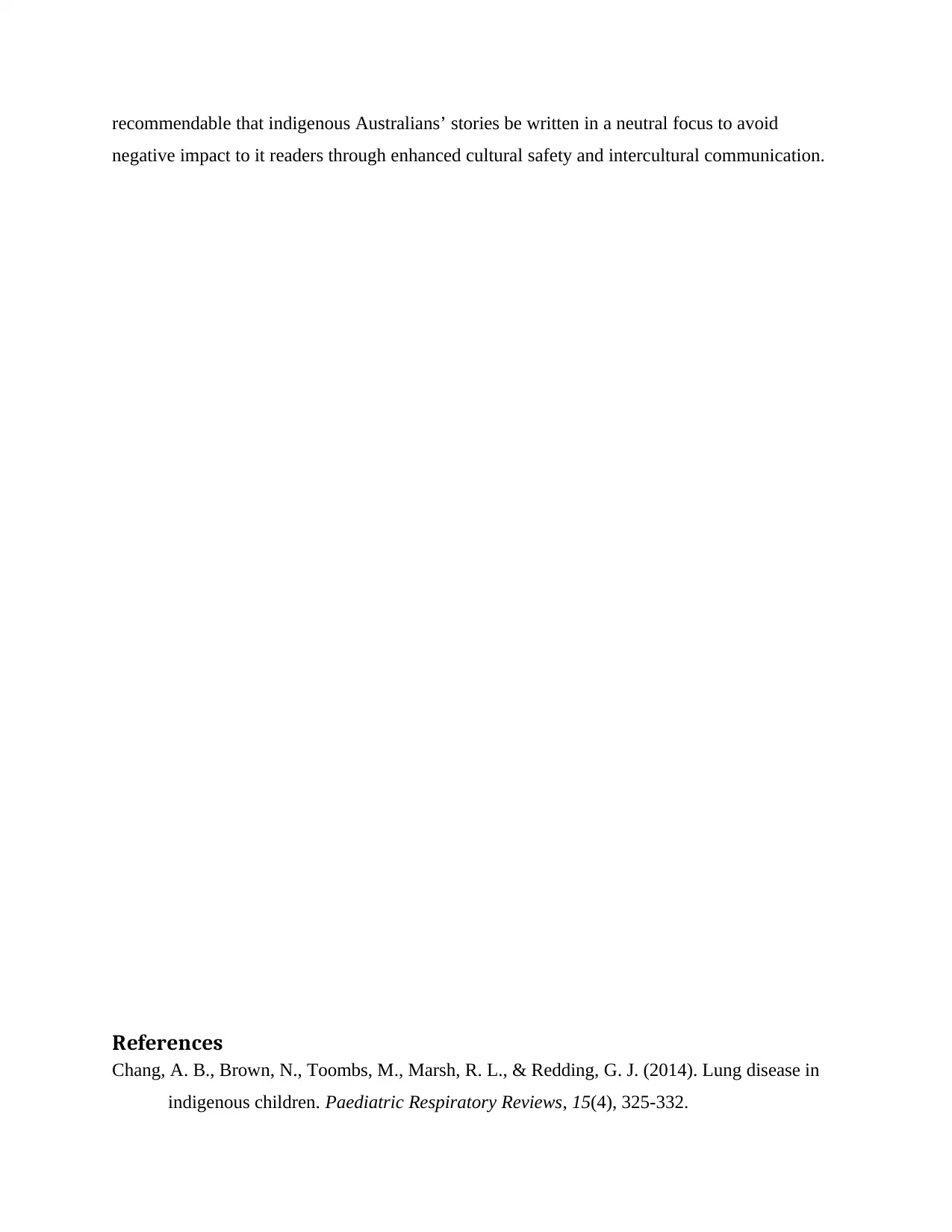
recommendable that indigenous Australians’ stories be written in a neutral focus to avoid
negative impact to it readers through enhanced cultural safety and intercultural communication.
References
Chang, A. B., Brown, N., Toombs, M., Marsh, R. L., & Redding, G. J. (2014). Lung disease in
indigenous children. Paediatric Respiratory Reviews, 15(4), 325-332.
negative impact to it readers through enhanced cultural safety and intercultural communication.
References
Chang, A. B., Brown, N., Toombs, M., Marsh, R. L., & Redding, G. J. (2014). Lung disease in
indigenous children. Paediatric Respiratory Reviews, 15(4), 325-332.
Paraphrase This Document
Need a fresh take? Get an instant paraphrase of this document with our AI Paraphraser

Davidson, H. (2016). Indigenous health: Aboriginal and Torres Strait Islander smoking rate
drops below 40%. Retrieved from
https://www.theguardian.com/australia-news/2016/apr/28/indigenous-health-aboriginal-
and-torres-strait-islander-smoking-rate-drops-below-40
Gould, G. S., Watt, K., Stevenson, L., McEwen, A., Cadet-James, Y., & Clough, A. R. (2014).
Developing anti-tobacco messages for Australian Aboriginal and Torres Strait Islander
peoples: evidence from a national cross-sectional survey. BMC Public Health, 14(1), 250.
Mercer, P. (2018). Program Tackles Sky High Rates of Aboriginal Smoking in Australia.
Retrieved from https://www.voanews.com/a/program-tackles-sky-high-rates-of-
aboriginal-smoking-in-australia/4683248.html
Mills, T. A., Lavender, R., & Lavender, T. (2015). “Forty is the new twenty”: an analysis of
British media portrayals of older mothers. Sexual & Reproductive Healthcare, 6(2), 88-
94.
Rosen, L. D., Lim, A. F., Felt, J., Carrier, L. M., Cheever, N. A., Lara-Ruiz, J. M., ... & Rokkum,
J. (2014). Media and technology use predicts ill-being among children, preteens and
teenagers independent of the negative health impacts of exercise and eating
habits. Computers in human behavior, 35, 364-375.
Smiley, S. (2017). Colonial practices implicated in Indigenous smoking rates. Retrieved from
https://www.abc.net.au/news/2017-10-11/indigenous-smoking-colonial-practices-
implicated/9037036
Stoneham, M., Goodman, J., & Daube, M. (2014). The portrayal of Indigenous health in selected
Australian media. The International Indigenous Policy Journal, 5(1), 1-13.
Sweet, M. A., Dudgeon, P., McCallum, K., & Ricketson, M. D. (2014). Decolonising practices:
can journalism learn from health care to improve Indigenous health outcomes?. Medical
Journal of Australia, 200(11), 626-627.
drops below 40%. Retrieved from
https://www.theguardian.com/australia-news/2016/apr/28/indigenous-health-aboriginal-
and-torres-strait-islander-smoking-rate-drops-below-40
Gould, G. S., Watt, K., Stevenson, L., McEwen, A., Cadet-James, Y., & Clough, A. R. (2014).
Developing anti-tobacco messages for Australian Aboriginal and Torres Strait Islander
peoples: evidence from a national cross-sectional survey. BMC Public Health, 14(1), 250.
Mercer, P. (2018). Program Tackles Sky High Rates of Aboriginal Smoking in Australia.
Retrieved from https://www.voanews.com/a/program-tackles-sky-high-rates-of-
aboriginal-smoking-in-australia/4683248.html
Mills, T. A., Lavender, R., & Lavender, T. (2015). “Forty is the new twenty”: an analysis of
British media portrayals of older mothers. Sexual & Reproductive Healthcare, 6(2), 88-
94.
Rosen, L. D., Lim, A. F., Felt, J., Carrier, L. M., Cheever, N. A., Lara-Ruiz, J. M., ... & Rokkum,
J. (2014). Media and technology use predicts ill-being among children, preteens and
teenagers independent of the negative health impacts of exercise and eating
habits. Computers in human behavior, 35, 364-375.
Smiley, S. (2017). Colonial practices implicated in Indigenous smoking rates. Retrieved from
https://www.abc.net.au/news/2017-10-11/indigenous-smoking-colonial-practices-
implicated/9037036
Stoneham, M., Goodman, J., & Daube, M. (2014). The portrayal of Indigenous health in selected
Australian media. The International Indigenous Policy Journal, 5(1), 1-13.
Sweet, M. A., Dudgeon, P., McCallum, K., & Ricketson, M. D. (2014). Decolonising practices:
can journalism learn from health care to improve Indigenous health outcomes?. Medical
Journal of Australia, 200(11), 626-627.
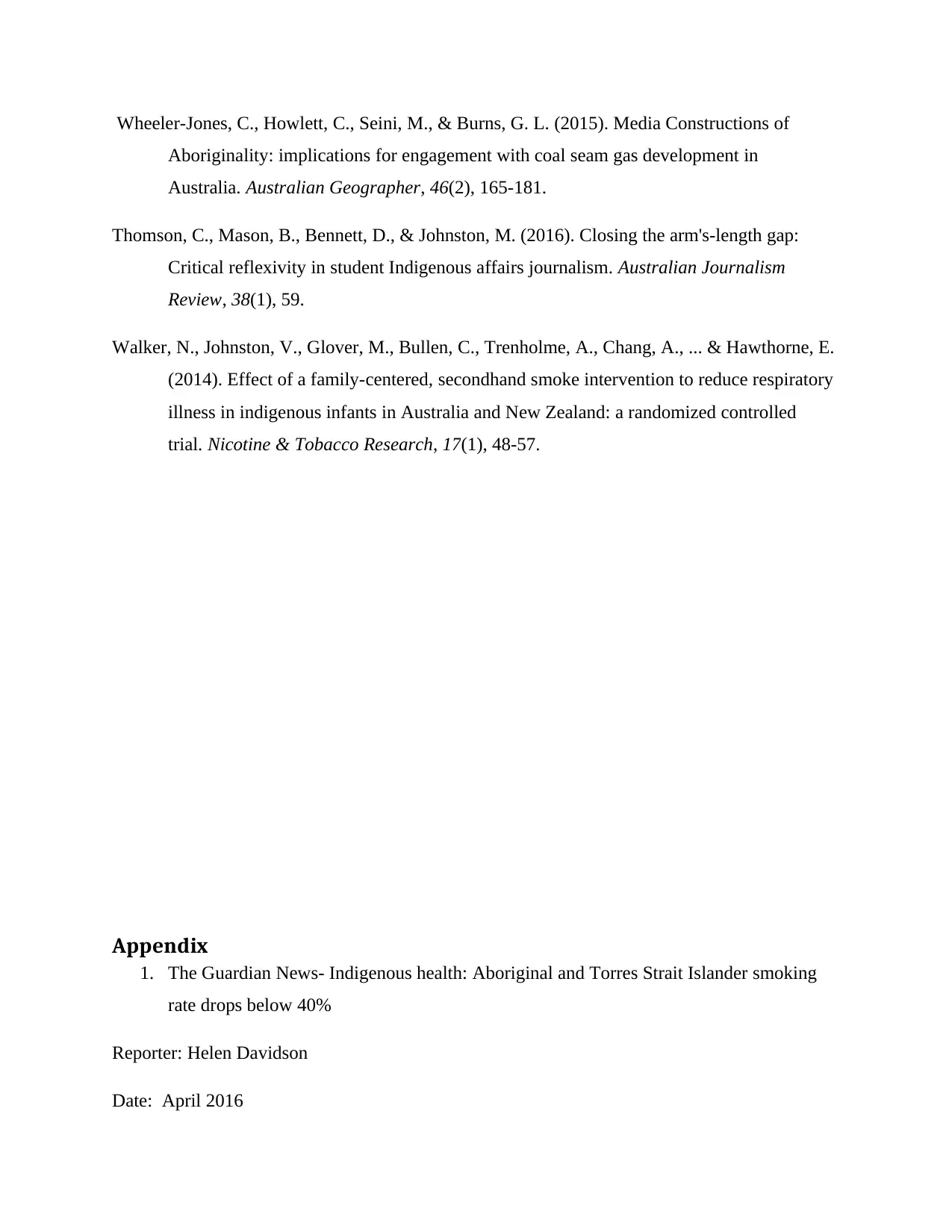
Wheeler-Jones, C., Howlett, C., Seini, M., & Burns, G. L. (2015). Media Constructions of
Aboriginality: implications for engagement with coal seam gas development in
Australia. Australian Geographer, 46(2), 165-181.
Thomson, C., Mason, B., Bennett, D., & Johnston, M. (2016). Closing the arm's-length gap:
Critical reflexivity in student Indigenous affairs journalism. Australian Journalism
Review, 38(1), 59.
Walker, N., Johnston, V., Glover, M., Bullen, C., Trenholme, A., Chang, A., ... & Hawthorne, E.
(2014). Effect of a family-centered, secondhand smoke intervention to reduce respiratory
illness in indigenous infants in Australia and New Zealand: a randomized controlled
trial. Nicotine & Tobacco Research, 17(1), 48-57.
Appendix
1. The Guardian News- Indigenous health: Aboriginal and Torres Strait Islander smoking
rate drops below 40%
Reporter: Helen Davidson
Date: April 2016
Aboriginality: implications for engagement with coal seam gas development in
Australia. Australian Geographer, 46(2), 165-181.
Thomson, C., Mason, B., Bennett, D., & Johnston, M. (2016). Closing the arm's-length gap:
Critical reflexivity in student Indigenous affairs journalism. Australian Journalism
Review, 38(1), 59.
Walker, N., Johnston, V., Glover, M., Bullen, C., Trenholme, A., Chang, A., ... & Hawthorne, E.
(2014). Effect of a family-centered, secondhand smoke intervention to reduce respiratory
illness in indigenous infants in Australia and New Zealand: a randomized controlled
trial. Nicotine & Tobacco Research, 17(1), 48-57.
Appendix
1. The Guardian News- Indigenous health: Aboriginal and Torres Strait Islander smoking
rate drops below 40%
Reporter: Helen Davidson
Date: April 2016

Link: https://www.theguardian.com/australia-news/2016/apr/28/indigenous-health-aboriginal-
and-torres-strait-islander-smoking-rate-drops-below-40
2. ABC News- ABC News- Why are Indigenous smoking rates high? Colonialism, that's
why
Reporter: Stephen Smiley
Dates: 11th Oct 2017
link: https://www.abc.net.au/news/2017-10-11/indigenous-smoking-colonial-practices-
implicated/9037036
3. VOA East Asia News- Program Tackles Sky High Rates of Aboriginal Smoking in
Australia
Reporter: Phil Mercer
Dates: 2nd December 2018
Link: https://www.voanews.com/a/program-tackles-sky-high-rates-of-aboriginal-smoking-in-
australia/4683248.html
and-torres-strait-islander-smoking-rate-drops-below-40
2. ABC News- ABC News- Why are Indigenous smoking rates high? Colonialism, that's
why
Reporter: Stephen Smiley
Dates: 11th Oct 2017
link: https://www.abc.net.au/news/2017-10-11/indigenous-smoking-colonial-practices-
implicated/9037036
3. VOA East Asia News- Program Tackles Sky High Rates of Aboriginal Smoking in
Australia
Reporter: Phil Mercer
Dates: 2nd December 2018
Link: https://www.voanews.com/a/program-tackles-sky-high-rates-of-aboriginal-smoking-in-
australia/4683248.html
1 out of 10
Related Documents
Your All-in-One AI-Powered Toolkit for Academic Success.
+13062052269
info@desklib.com
Available 24*7 on WhatsApp / Email
![[object Object]](/_next/static/media/star-bottom.7253800d.svg)
Unlock your academic potential
© 2024 | Zucol Services PVT LTD | All rights reserved.
